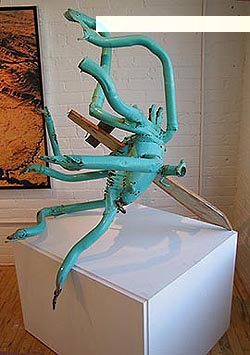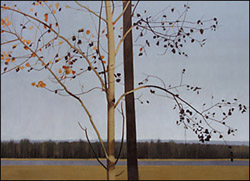Gallery Stroll
Review
Kasey at the
Bat
You probably have a week to ten days left to see the current exhibitions
at participating Salt Lake galleries before the next Gallery Stroll.
Here’s Kasey Boone's World Series take on what there is to see.
HOME RUN: If you
only have time to make it to one exhibition in the next couple of
weeks, make it to the Forum's Making Our
Mark. The Forum made a bold move by putting on an exhibition
of printmakers, sometimes thought of as the poor cousins of the fine art
world, only a step above photographers. The Forum took a big swing,
and if you stop by the show I think you'll see they hit this one hard
and out of the ballpark. The variety and quality of the artists involved
is what makes this exhibition exceptional. This show demonstrates just
how strong and versatile a medium printmaking can be. As these artists
demonstrate, printmaking is just like any other medium -- in the hands
of the right craftsmen it allows the artists personality to shine through.
Works can be light, as in Bob Kleinschmidt's Putti Pearl Diving --
showing two "putti" diving downward after what appear to be halos. Or
in the hands of another of Salt Lake's best printmakers, the print can
take on a searing intensity, as in Karl Pace's Burning For Your Love.
With thirteen other fine artists, there's something for everyone to catch.
A home run. Forum Gallery, 511 West 200 South, SLC wed - sat, noon to 5.

TRIPLE: Art Access:
"Curated" shows (shows involving a number of artists built around
a theme) may be producing the most interesting exhibits in town. Normally,
I prefer to look deep -- usually at one artist in a one-person show.
But what I like about some of the shows I've seen recently, and especially
this month, is the relationships established when a number of artists
are shown together. The Art Access exhibit proves this point. "Opening
a Dialogue allows various Utah artists, or, rather, their works, to
dialogue with each other. In this show, the topic of the environment
has given them the chance to talk. Art Access is always
deft at packing in the most bang for your buck in their small exhibition
space. Chris Peterson, curator of the exhibit, has an astonishingly
simple and direct piece that works great as an artistic statement and
an environmental statement. A large insect-like monster is impaled with
a simple sword made out of two pieces of old wood. The title reads The
Citizens' Battle Against Magcorp. The work is the environmentalists
"St. George slaying the Dragon." As often with Art Access, the works shown
are an eclectic mix asking the viewer to reconsider their traditional
notions of art. From traditional landscapes to
installation art. Thought-provoking and visually stimulating.
Base Hit: Like the Forum exhibition,
HORNE Fine Art'
s show Dusk to Dawn gets the strength of its hit from the breadth
of its artists. Fifteen artists explore the time between dusk and dawn
in these nightscapes, using a variety of media. Stylistically, most of
the works are done in a "realistic" manner, which can range from the
academic to the wonderfully nuanced. Horne Fine Art gives the public the
subtlety of Doug Braithwaite and the unique vision of Brad Slaugh, mixed
in with some captivating scenes by Ken Baxter and a number of other local
artists. Unfortunately, as a whole the exhibition doesn't seem to work
as well as some of its individual parts. Some of the pieces seem to happen
across night, rather than being any explicit statement about it. A good
base hit.

Double: Connie Borup at
Phillips Gallery
. Borup's paintings have a calm insistence about
them. They are hung on the rack of a Mondrianesque grid structure,
firm horizontal lines crossed by a strong vertical reaching from top
to bottom. She clothes this structure in twilight and bare tree trunks.
This repetition of structure and form is the element of her body of work
that gives it such impact. It may also be its weakness. For a painter who
can be very delicate and very strong at the same time, one might hope to
see in what other directions she can go. If you like what you've seen of
Borup's work over the past few years, this exhibit will not disappoint;
though it is not likely to surprise. A strong double to left field.
Sliding Double: Shawn
Rossiter
at Chroma Gallery.
I took this artist to task in a review last year for not deciding
what he wants to do. In this exhibition he seems to be getting closer
to a vision. The Chroma Gallery exhibition shows a number of abstracted
pastels, ranging from cubist, Picasso-like depictions of the human form,
to completely non-objective renderings of line, form and color. While
in my last review I thought Rossiter's best works were his landscapes, I
think it is in these abstracted pastels that he begins to show a personal
vision. The looseness and experimentation of what are essentially drawings
have a force and wonder about them that are compelling. I give him a sliding
double.
--Kasey Boone, 15 Bytes
|
|
|
Art Forum
Controversies in
the SL County Art Collection
The Salt Lake County’s
Brown Bag Discussion Series "Art Too! Art Not!" concluded this past month,
with the final panel discussion "Controversies in the Salt Lake County
Art Collection" held on Friday, October 17th.
Dave Ericson
and William Seifrit, both of whom were on the committee which helped
create the current Salt Lake County art collection, spoke about the genesis,
life and future of what Seifrit characterized as the "largest single
array of Utah art on public display in the state."
Ericson,
who owns and operates Ericson Fine Art in Salt Lake City, and Seifrit,
who has written on Utah Art, were both on the County's Art Acquisition
Committee, which made the first new purchases for the County Collection
in the mid-80s. Seifrit found the experience delightful: "We had the time
of our lives, . . . going from Springville to Logan . . . meeting with
artists in garages and the back rooms of galleries."
The Art Acquisition
Committee was formed by the County Art Advisory Board, which, in the
mid-1980s, took advantage of new percent-for-art legislation and plans
for a new County government building at 2100 South State, to form a County
Art Collection.
As Ericson
pointed out, when the Acquisition Committee began acquiring works in
1985, they had to decide what type of collection they should create. The
County already owned a small art collection, mostly early works from
the WPA era. In order to avoid creating a collection only of the 1930s and
the 1980s, the Committee carefully selected works done between the 1930s
and 1980s while also purchasing contemporary pieces.
The Acquisition
Committee imposed other guidelines, or restrictions, on themselves. They
attempted to avoid any works that were controversial, religious, of
a political nature, or depicting nudes. "Which pretty much reduces it
to landscapes and still-lifes," as Seifrit pointed out.
These self-imposed
restrictions did not keep the Committee from encountering controversy
or difficulty. Ericson and Seifrit recalled Tom Barberi (local radio host)
lambasting them almost weekly as the collection was being created. Barberi
thought it ridiculous to spend taxpayer funds on art.
During the
panel discussion, Ericson and Seifrit were eager to point out how well
served the taxpayers investment has been. In 1985, $250,000 (1% of the
construction costs of the new County building) was allocated to the collection.
Due to the help of artists and galleries, the committee only ended up spending
half that -- $150,000, or about ten cents per county resident. The collection
was recently appraised at close to $1.5 million -- making the per-resident
return on a ten cent investment one dollar. In addition, as Ericson pointed
out, the collection has in the meantime provided entertainment, culture
and dialogue.
Dialogue
was certainly in the minds of Ericson and Seifrit when they helped to
make the collection. It was obvious from comments from both that the fact
that the collection was "public" rather than private was in the forefront
of their selection process. They wanted works that would create a public
dialogue, which might not necessarily be works that one would stick over
one's fireplace. And dialogue does create controversy.
Despite their
self-imposed restrictions, the committee did choose works which proved
to be controversial.
One, a portrait
by the late Danny Baxter, has received many negative comments since
it was placed in the County building. In this painting, a young man lounges
in a car seat, seen from within the car, leaning against the window,
his face twisted into something between a sneer and a snarl. Visitors
and employees have said he looks like a child molestor or murderer.
|
|
Mixed Media:
Recent Visual Arts Articles
11/2 Wry and witty art Exhibit by Brian Kershisnik opens at Ericson
gallery Friday
10/30 Artists explore Utah environmental issues by “Opening
a Dialogue.”
10/23 Mainly Art gives downtown streets a spark of creative
energy.
10/19 Industrial art in downtown S.L.
10/16 Scott Carrier expandshis documentary vision to photography
10/12 Photographs both entice and repulse
10/05 Valoy Eaton is true painter of light
If you can track down a copy of Southwest Art's October
edition you'll find a fine article on Bountiful's Chris Thornock.
Also, you'll find a short write-up on Odgen's Shanna
Kunz as an "Artist to Watch."
ART TOO!
ART NOT!
the sequel?
Please take a moment to fill out our survey.
|
|
|
Ericson defended the painting and its inclusion in the collection. It was
painted in 1969, when Baxter had been asked to watch after the young man
portrayed -- babysit him, essentially. He was, in fact, a bad kid. He
is pictured in a VW Bug from the era, dressed in an army jacket, with
long hair. Ericson says that Baxter "captured the time and attitudes
of a member of our society at the time. . . He's painting a real guy
in a real situation." The painting is what Seifrit described as "a moment
of captured actuality."
Ericson thinks
the piece belongs in a public collection like the County's because "in
a public place it represents part of our public."
Another controversial
piece in the collection, displayed and discussed during
Art Too! Art Not! was by Sherrie Ernst. Three figures
are seen in an interior setting. A woman ascends a staircase. A man,
darkly lit, is half prone in the foreground, and a young girl is scene
by the front door, holding a ball and reading some thing.
Seifrit described
the piece as "a cubic ton of emotion and an endless saga of untold narrative."
The figures are all in different lighting and all seem oblivious of each
other. Ericson finds the work compelling because, though done in a realistic
manner, it goes past mere illustration. "The artist," he said, "has given
you a variety of scenarious and is asking you to resolve it yourself."
He thinks the work has probably caused discomfort because "some people
aren't prepared to fill in the blanks."
The County
has continued to purchase artwork for the collection. All work purchased
must be displayed in a public location, and much of it can be viewed at
the County building at 2100 South State.
When asked if
he had any advice for the present Committee in its process of purchasing
new works, Seifrit had these words of advice: "Be willing to take the occasional
risk from time to time . . . make a sincere effort to identify young artists
with promise and encourage them with a purchase."
|

|
|
